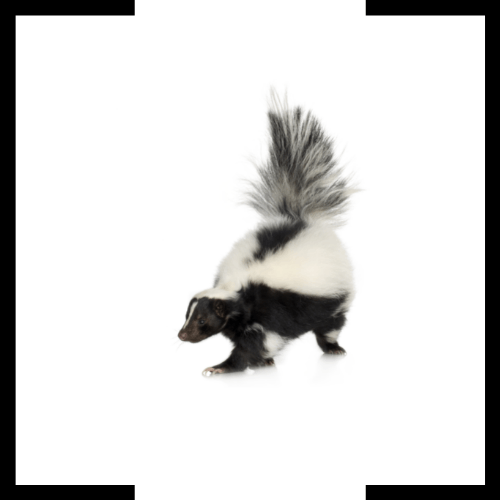Skunks are intelligent, adaptable animals that thrive in nearly any habitat that provides food, water, and shelter. Rarely venturing more than two miles from its den, they are not typically found beyond a couple of mile radius of a sustainable water source. Dens are made in tree hollows and logs, brush piles, underground burrows, and under structures resting above a dirt surface.
Understanding Skunks
Like many mammals, skunks are most active at night. They don’t hibernate in winter (though they’re less active), but form group dens to share warmth. In warmer weather, they tend to prefer solitude. They are opportunistic feeders, dining on everything from snakes, frogs, scorpions, and cockroaches, to small rodents. Of course, they won’t hesitate to add the contents of your garbage can or your pet’s food bowl to their menu, as well.
It’s more likely you’ll smell skunks than that you’ll see them. A constant musky smell that doesn’t dissipate after a day or two is a sure sign that one or more skunks have taken up residence on your property. What they are most famous (or perhaps infamous) for is their defensive ability to emit a rank, burning spray from their anal glands to drive off anything or anyone which they perceive as a threat. Typically, skunks won’t attack unless they’re cornered or defending their young, which usually can’t be determined until after an attack.
Contrary to popular belief, they don't immediately resort to spraying when they feel threatened. Initially, they employ less aggressive tactics such as growling, snarling, and stamping the ground with their forepaws in an attempt to deter potential threats. It's only when these preliminary warnings are ignored that their behavior escalates. The first real indication of impending spray is a twitch of their tail—a clear signal to back off. If the threat persists, the skunk then lifts its tail straight up as a final preparation to spray. While they might appear cute and cuddly as depicted in films, their interaction with humans and pets can be less than pleasant.
Problems They Cause
Beyond the notorious odor they can unleash, skunks pose a more serious risk due to their potential to carry and transmit diseases. Among these are leptospirosis, a bacterial disease that affects both animals and humans; canine distemper and hepatitis, which pose significant risks to dogs; and intestinal roundworm, which can cause a variety of health issues in pets and people. These risks underscore the importance of maintaining a respectful distance from these white-striped animals, regardless of their seemingly harmless appearance. They can also carry rabies, a particularly dreaded disease that can be transmitted to both pets and humans.
The most obvious sign that a skunk has moved in is the horrific amount of damage they can cause to lawns and gardens when digging burrows or searching for food. But, far more troublesome, and expensive, is the havoc they can wreak underneath a house, damaging electrical wiring, plumbing, vent nets, and digging under foundations. Of course, should a predator go under there after them and they spray, the smell can permeate an entire home.
The simplest solution for evicting your smelly free-loader is to hire a licensed wildlife removal professional like the team at Agricole Wildlife Solutions. We help homeowners remove pests using the latest trapping and baiting methods. Contact us today for a consultation.
Frequently Asked Skunk Questions
Q1. Why do skunks spray, and how can I prevent it from happening near my home?
A1. They spray as a defense mechanism when they feel threatened. This spray is a strong-smelling oil produced by glands under their tail. To prevent skunks from spraying near your home, it's essential to make your property less attractive to them. This can be done by securing trash cans with tight-fitting lids, removing outdoor pet food at night, and blocking access to potential shelter areas like decks, sheds, or crawl spaces. Additionally, using motion-activated lights or sprinklers can scare them away before they feel threatened enough to spray.
Q2. What should I do if a skunk gets into my house or garage?
A2. If one finds its way into your house or garage, it's crucial to stay calm and avoid startling the animal, as this could trigger it to spray. First, provide a clear, unobstructed path for the skunk to leave. You can do this by opening doors or garage doors wide. Then, dim the lights and minimize noise and movements to create a calm environment. You may also place a trail of smelly foods like canned fish to guide the skunk outside. If the animal doesn't leave on its own, you might need to contact local wildlife control professionals who can efficiently and humanely remove it.
Q3. How can I get rid of skunk smell?
A3. Getting rid of skunk smell can be challenging due to the oil's ability to stick to surfaces and penetrate materials. For pets, a bath with a mixture of baking soda, hydrogen peroxide, and dish soap can help neutralize the odor (but check with a vet first to ensure it's safe for your pet). For clothing or fabrics, washing with regular laundry detergent and adding a cup of baking soda to the wash can help remove the smell. In the case of outdoor or large area deodorization, commercial products designed to neutralize the odor can be effective. Ventilating the area and using air purifiers can also help remove the smell from indoor environments. Remember, it may take multiple treatments to completely eliminate the odor.


